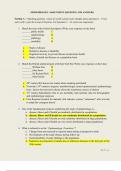Exam (elaborations)
EPIDEMIOLOGY ASSIGNMENT-QUESTION AND ANSWER LATEST UPDATE 2024/2025
- Course
- Institution
EPIDEMIOLOGY ASSIGNMENT-QUESTION AND ANSWERS Section A – Matching questions 1 and 2 are worth 2 points each; multiple choice questions 3 – 18 are each worth 1 point for a total of 20 points. For Questions 3 – 18, circle your response(s) 1. Match the term with its brief description (Writ...
[Show more]



